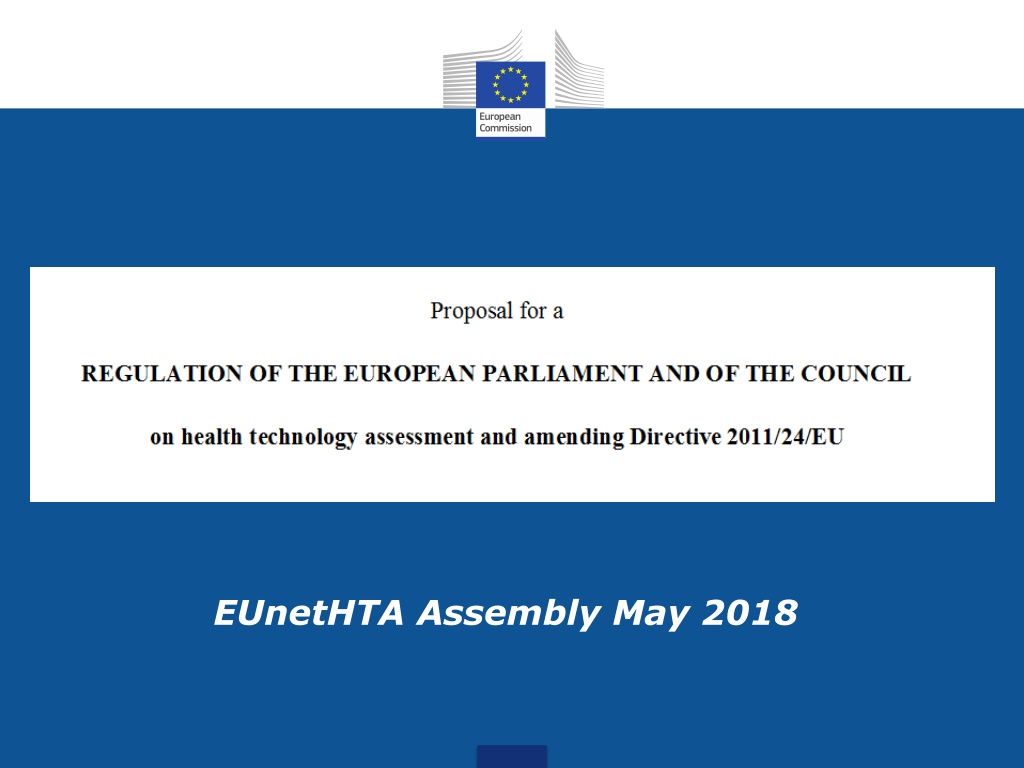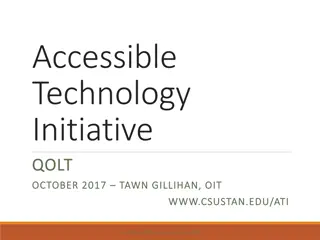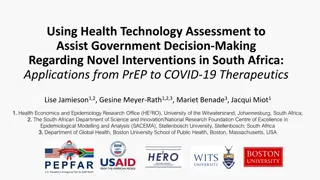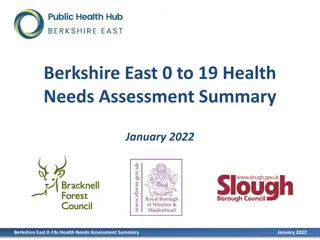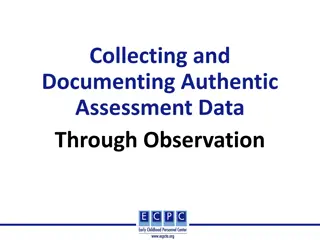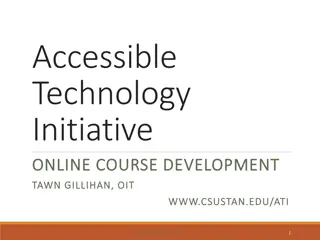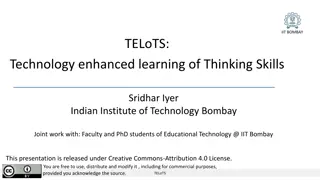EU Health Technology Assessment Initiative Overview
The EUnetHTA assembly in May 2018 discussed the background, key milestones, objectives, outcomes, and proposal of the Health Technology Assessment (HTA) initiative. The initiative aims to promote convergence in HTA tools, reduce duplication of efforts, ensure sustainability, and bring positive impacts on business, Member States, and patients by enhancing transparency and efficiency in the HTA process.
Download Presentation

Please find below an Image/Link to download the presentation.
The content on the website is provided AS IS for your information and personal use only. It may not be sold, licensed, or shared on other websites without obtaining consent from the author.If you encounter any issues during the download, it is possible that the publisher has removed the file from their server.
You are allowed to download the files provided on this website for personal or commercial use, subject to the condition that they are used lawfully. All files are the property of their respective owners.
The content on the website is provided AS IS for your information and personal use only. It may not be sold, licensed, or shared on other websites without obtaining consent from the author.
E N D
Presentation Transcript
Background Why an HTA initiative? More than 20 years of cooperation: projects, joint actions ACHIEVEMENTS LIMITATIONS Trust between HTA bodies Low uptake of joint work duplication of work Capacity building Differences in the procedural framework and administrative capacities of Member States Development of joint tools (e.g. EUnetHTA Core Model, POP EVIDENT databases) Piloting joint work (e.g. early dialogues, joint assessments) Differences in national methodologies No sustainability of current cooperation model 3
Background Key milestones - Inception impact assessment (IIA) - Published September 2016 - Consultation - Online public consultation Report May 2017 - Meetings with EUnetHTA JA3 and HTA Network - Discussions with stakeholders - Studies to support the IA process - Impact assessment finalisedOctober 2017 - Commission legal proposal 31 January 2018
OBJECTIVES Operational objectives Promote convergence in HTA tools, procedures and methodologies Reduce duplication of efforts for HTA bodies and industry Ensure the uptake of joint outputs in Member States Ensure the long-term sustainability of EU cooperation
OUTCOMES Expected outcomes Industry Positive impact on business predictability, competitiveness and innovation Savings (reduced duplication) Member States High quality and timely reports Pooling of expertise specialisation of HTA bodies Better allocation of resources Savings in the long run, contribution to sustainability of healthcare systems Patients Increased transparency Increased engagement in the HTA process at national and EU level Potential faster access across EU
PROPOSAL Article 1 The Regulation establishes: support framework and procedures for cooperation on health technology assessment at Union level common rules for clinical assessment of health technologies The Regulation shall not affect the rights and obligations of Member States with regard to the organisation and delivery of health services and medical care and the allocation of resources assigned to them.
PROPOSAL Key elements (1) Provides support framework and procedures for EU cooperation on HTA Well defined scope the transition period Article 5 Medicinal products with central marketing authorisation: Selection during New active substances New therapeutic indications for existing substances Medical devices classified as class IIb and IIIfor which the relevant expert panels have provided a scientific opinion in the framework of the clinical evaluation consultation procedure permanent Selection In vitro diagnostic medical devices - class D for which the relevant expert panels have provided their views in the framework of the clinical evaluation consultation procedure
PROPOSAL Examples of high-risk medical devices High risk devices IIb), III and IVD class D subject to opinions of expert panels under the medical devices regulation
PROPOSAL Key elements (2) Focus on clinical aspects Enable synergies between regulatory and HTA issues 11, 16 Articles Defined areas of join work: Joint scientific consultations/JSC (early dialogues) Joint clinical assessments/JCA (REA) Horizon scanning Voluntary cooperation Articles 5-11 Articles 12-17 Article 18 Article 19
PROPOSAL Building on the work of EUnetHTA JAs Areas of joint work Building on the work of EUnetHTA JAs
PROPOSAL Key elements (3) Member States driven approach Articles 6, 13 National agencies to do scientific work Articles 3-4 Annual programme decided by the Coordination group Articles 6, 13 Approval of joint reports by Coordination Group Article 25 EC to provide secretariat (administrative, scientific, IT) EC to publish the joint reports Obligationsfor health technology developers to submit a dossier Obligations for HTA bodies not to repeat the joint clinical assessments Articles 7, 27 Article 5 Article 8
PROPOSAL Member State-driven approach Article 3 HTA Coordination Group (CG) Member State-led members designated, one or more authority or body Will manage the overall governance of the joint work Will meet regularly to provide guidance and steer the cooperation. Will work based on an annual work programme developed and adopted by the Group
PROPOSAL Key elements (4) High quality Member States experts Timely output For medicinal products by the time of publication of the EC Decision granting marketing authorisation For medical devices flexible timeline (at or after market launch) Transparency and independence Pragmatic phase-in approach Recitals 17-18 Article 22.1. Articles 33, 36
Preparation of JCA Report Health technology developer (HTD) Obligatory submission of documentation (comprehensive evidence) Article 6 Coordination Group Joint clinical assessment (JCA) Sub-group - Verify completeness of documentation: if needed request additional information from HTD - Analyse the documentation submitted - Incorporate input from the other members of the SG in the preparation phase (e.g. comparators, patient populations, endpoints) - Consult and incorporate input from external experts (patients, clinical experts) - Prepare JCA draft report, incorporating comments from the other members of the SG - Submits final JCA report to the CG Draft JCA report Assessor & co-assessor Coordination Group Approval Final JCA report -> Publication by EC
PROPOSAL Article 26 MP = medicinal products, MD = medical devices
Assessment vs appraisal Article 6, 8, and Recital 16 Joint clinical assessment Conclusions limited to: (a) an analysis of the relative effects of the health technology being assessed on the patient-relevant health outcomes chosen for the assessment (b) the degree of certainty on the relative effects based on the available evidence. EU 1 NATIONAL 28 NATIONAL APPRAISAL of joint clinical assessment and additional context-specific considerations (e.g. number of patients affected in MS, how patients are currently treated in the healthcare system, costs) +/- economic, ethical organisational, legal Conclusions on added value (e.g. added therapeutic value, cost-effectiveness ) NATIONAL DECISION MAKING (e.g. P&R)
Articles 33, 36 Phase-in approach Timeline DRAFTING IMPLEMENTING AND DELEGATED ACTS 3 years CO-DECISION PROCEDURE 3 years Commission proposal Entry into force Date of application All MS Transition period Member States may delay their participation in the system of JCA and JSC until 3 years after the date of application Prioritization of health technologies subject to JCA, JSC + Recitals 29-30
Thank you! Contact: SANTE-HTA@ec.europa.eu 19
